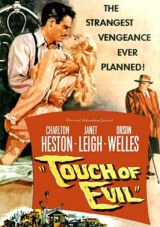|
Touch of Evil
|
| |
 |
USA, 1958. Rated PG-13. 105 minutes
(restored version)
Cast:
Charlton Heston, Orson Welles, Janet Leigh, Joseph Calleia, Akim Tamiroff,
Marlene Deitrich, Joanna Cook Moore, Ray Collins, Valentin de Vargas,
Dennis Weaver, Mort Mills, Zsa Zsa Gabor
Writer: Orson Welles & Paul Monash (uncredited), based on the novel
Badge of Evil, by Whit Masterson
Music: Henry Mancini
Cinematographer: Russell Metty
Producers: Albert Zugsmith, Rick Schmidlin (1998 restoration &
director's cut)
Director: Orson Welles
LINKS
|
 ouch
of Evil embodies everything that is so exhilarating and maddening about
Welles. Both inspired and confused, Touch of Evil is the work of a master
who cannot quite give life on screen to what he imagines in his head. While
there was certainly interference from the commercially minded studio, an audience
can have a tough time accompanying a maverick more intent on exploring his inner
vision than with communicating that vision.
ouch
of Evil embodies everything that is so exhilarating and maddening about
Welles. Both inspired and confused, Touch of Evil is the work of a master
who cannot quite give life on screen to what he imagines in his head. While
there was certainly interference from the commercially minded studio, an audience
can have a tough time accompanying a maverick more intent on exploring his inner
vision than with communicating that vision.
Perhaps this is unfair. I'm no Welles expert, and I may be reading too much
into the final result. After all, "Welles" and "commercially palatable" are
mutually exclusive concepts, so any attempt to reconcile the two is doomed to
fail. Forty years later, producer Rich Schmidlin has attempted to make the modifications
recommended by Welles to the final cut made by the studio. This version of Touch
of Evil is not a director's cut so much as an attempt to rescue some of
the director's vision from the studio-approved version.
Yet Welles is known for his chaotic productions. Few of his works possess the
clarity of Citizen Kane. They may have the same complex ambiguity and
the same mastery behind the camera, but all too often they also feel muddled
and incomplete. Like the half-finished statues Michelangelo sculpted in the
last few decades of his life, they are partially finished bodies still trapped
in rock. 
Touch of Evil opens with a camera sequence that Scorcese would be proud
of today, half a century later. Beginning with the placement of a bomb in the
trunk of a car, the camera tracks both the slow-moving car and a couple of pedestrians
(Charlton Heston and Janet Leigh) through several blocks of a Mexican border
town and over the border into the United States, until the car finally explodes--all
in a single take lasting several minutes. The film's climactic sequence, with
its tricky lighting and camera angles, is similarly accomplished.
The trouble is, what comes between those opening and closing sequences isn't
nearly as compelling. Because the bomb detonates north of the border, the murder
investigation is in U.S. hands, specifically, those of unscrupulous American
cop Hank Quinlan (a huge, disheveled Welles, mumbling crankily). Mexican federal
agent "Mike" Vargas (Heston with a shameful fake tan and absolutely no accent)
tags along as an observer who develops serious misgivings about Quinlan's conduct.
At the same time, the local Mexican drug ring, led by "Uncle Joe" Grandi (Akim
Tamiroff) and "Pancho" (Valentin de Vargas, overacting badly), hatches a plot
to discredit Agent Vargas and his American wife, Susan (Leigh, doing a bit of
overacting herself). Oh, and Marlene Dietrich makes a cameo appearance for no
particularly important reason. She's meant to be a symbol of some sort, I think.
It's tricky to be both over the top and at least occasionally boring, but Touch
of Evil achieves this feat. Characters come and go, mentioning too many
names to remember easily, as the film lays down a lengthy exposition. Susan
has confrontations with Uncle Joe and the man she dubs "Pancho" (which would
be considered racist today, like calling any Italian "Guido") that provide unintentional
amusement (Leigh's attempts to sound tough are really quite funny), but they
don't become meaningful until later. Much, much later. It takes far too long
for Uncle Joe's scheme to come into relief and the main tension of the film
(between Vargas and Quinlan) to take hold. Once they do, though, the boredom
dissipates and Touch of Evil holds your attention.
The suspense of the last act and Welles' virtuoso direction make Touch of
Evil well worth seeking out, but don't expect cinematic ecstasy. The restored
version is doubtless superior to the theatrical release, but it fails to rescue
an artistically cohesive piece--assuming there even was an artistically cohesive
piece in the first place.
Review
© August 2002 by AboutFilm.Com and the author.
Images © Universal Pictures. All Rights Reserved.


